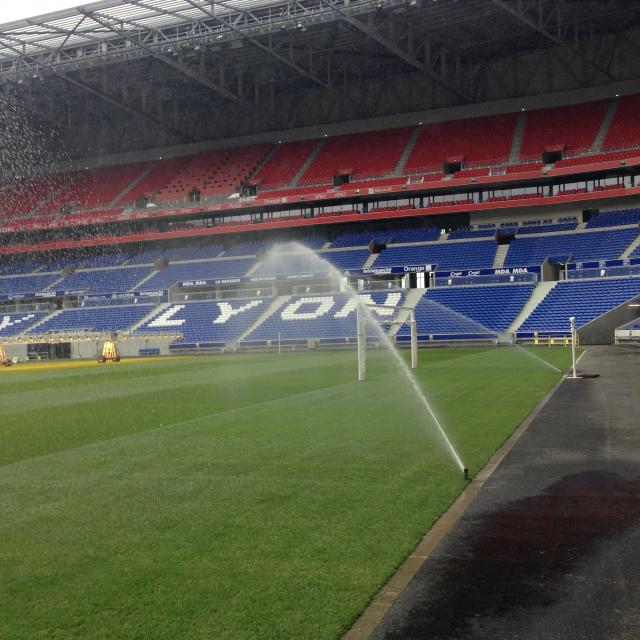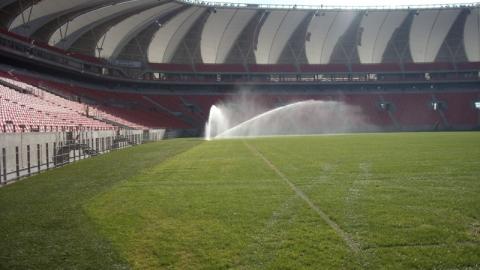Olympique Lyonnais has wanted to construct its own stadium because the Gerland stadium, which belongs to the city of Lyons, was too small. The work, which ended in December 2015, cost a total of 455 million euros. With a modifiable capacity of 59,000 seats, the shear size and modernity of the Parc Olympique Lyonnais makes it so impressive. A large training ground is being constructed nearby. The whole complex is watered with a Rain Bird irrigation system and managed by a SiteControl satellite-based central control unit.

Irrigation system for the main stadium
We then went to the main stadium with Vincent Trottet, a sales representative at Rain Bird. We were received by Marc Bisch from Id Verde, the company installing the irrigation system for the main stadium and car parks.
The main stadium is spectacular. The feeling of being inside an enclosed area intensifies the shear magnitude of the structure. The seating behind the goals matches the club’s colours, the kits being white with a red and blue stripe in the centre and the same applies to the stands at the side.
The irrigation system has 35 Rain Bird 8504 independent sprinklers, i.e. 7 rows of 5 spaced 21 metres apart.
The sprinklers selected are the Rain Bird 8504 series. Only sprinklers with a diameter of less than 60 mm are authorised by FIFA (zero risk for the players).
The installation has 35 valves, i.e. as many valves as there are sprinklers. In this way, each sprinkler can be activated independently of the others.
The stadium’s greenkeeper, responsible for programming the irrigation, gave us more information about the ground’s water requirements: “We apply a little water every day, if necessary. In fact, our irrigation programme is tailor-made to requirements.” And he continues: “When a match is being played, the turf is irrigated just before the game begins or at half time, so that the playing area will be as soft as possible for the players.”
The turf selected for the main stadium is the Natural Grass AirFibre type, a unique hybrid turf technology used for top level football and rugby fields. This 100% natural turf anchored in an artificial root substrate has several qualities: resistance to wrenching, optimum softness, heat insulation, very high permeability level and significant plant water retention. The turf is heated in order to obtain a temperature of 18 to 19° C. This prevents freezing and improves the turf’s rooting system.
The irrigation system is managed by a Rain Bird SiteControl satellite/decoder central control system. Thus, if the computer should fail, the satellites take over. “We cannot allow an irrigation system to break down in a Ligue 1 stadium”, explained Marc Bisch.
Furthermore, a rainwater recovery system has been installed for irrigating the turf. Very close to the pitch there is a 360 m3 buried tank for storing the collected rainwater. The rainwater is recovered from the stadium’s roofs and flows into the tank. When there is not enough rainwater to fill the tank, groundwater from the well (supplied by a borehole sunk under the stadium) is used. There are four Grundfos pumps submerged in the tank, three pumps are in use and one acts as a stand-by pump, operated by three variable speed drives and a control box.
At the time when we visited the stadium, large strips of lamps were illuminating the turf. “This is bright light therapy used to accelerate the growth of the grass,” explained Mr. Trottet. “An event took place at the weekend and the turf was damaged.” Being the only club in the French Ligue 1 to own its ground, OL has to organise other events apart from the matches (e.g. concerts) in order to make the stadium profitable.
Irrigation installation for the main stadium
• 660 metres of trenches
• 1500 metres of piping
• 35 sprinklers
• 35 solenoid valves
• 4 pumps, including one stand-by
• One filtration unit for each pump
Irrigation for the car parks
The company ID verde has also carried out the installation of an irrigation system for the stadium’s 9 car parks. Even though it was very costly, OL has decided to lay the car parks down to turf so as not to have to manage the runoff water.
The irrigation system used on the car parks has 350 Rain Bird 5505 sprinklers and 29 solenoid valves, all managed by the Rain Bird SiteControl central control system. The same central control system is used to manage the whole site (main stadium, car parks and training centre). Unlike the football grounds, which are irrigated all year round, the car parks are only watered in the summer.
OL has selected the Placage Terrafoot® turf product; a ready-to-use mixture made of natural materials and specially prepared for sports fields. This turf is unaffected by water and, therefore, it never becomes muddy or loses its shape and it is resistant to packing and resistant to frost or thawing.
Irrigation installation for the car parks
• 5830 metres of trenches
• 6150 metres of pipes and tubes
• 350 sprinklers
• 29 solenoid valves
Training centre
At the training ground we met Adrien Monin from Deal Hydraulique, the company installing the irrigation system at the centre.
This is an enormous project, with the work still in progress and delivery planned for June.
Once it has been completed, the training centre will have 5 pitches, one training ground and a pitch with artificial turf, as well as a building for accommodating the players. The pitch with artificial turf will not be watered, but the other six are irrigated.
We then went to the grounds that are in the process of being completed. The pitch is irrigated with 7 rows of 5 sprinklers across its width, i.e. 35 sprinklers in total. There are seven solenoid valves installed, one for each row of sprinklers. Rain Bird 8500 sprinklers and PGA 2000 solenoid valves are used.
Irrigation installation for the training centre
• 217 sprinklers
• 49 solenoid valves
• 2 pumps of 25 m3/h
+ one replacement pump.
• One 160 m3 tank
On the pitches where the matches will be played, the turf will be heated to 18-19 °C, as in the case of the main stadium.
A little further away, a man was digging a hole with an excavator, where the 160 m3 tank will be placed the next day. It will be supplied from the main stadium’s tank (rain water and groundwater).
The whole complex will be controlled by the Rain Bird SiteControl central control system, which is based near the main stadium.
The Parc Olympique Lyonnais held its first match with great success on 9th January of this year. After 6 months of use, the new stadium will be ready to host competitive Ligue 1 matches. In particular, it will host 6 matches at Euro 2016, which begins in July, as well as the final of the 2016 European Rugby Champions Cup final and the opening match and final of the 2019 Women’s Football World Cup.
Data sheet
Client : OL groupe – Foncière du Montout/Public-Private Partnership
Constructor : Vinci group
Firm of architects : Popoulus
Contractor for managing/installing the green spaces and lawns of the main stadium and training centre : Parcs et Sports
Irrigation contractor for the main stadium : Id Verde
Irrigation contractor for the training centre : Deal Hydraulique

